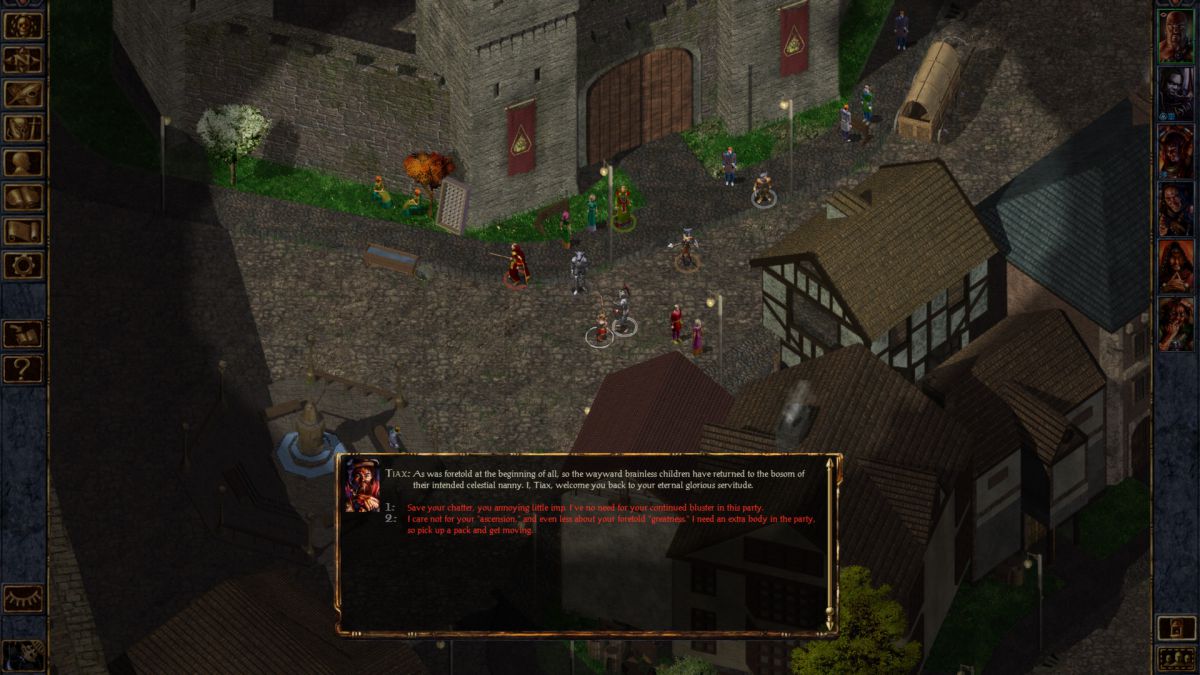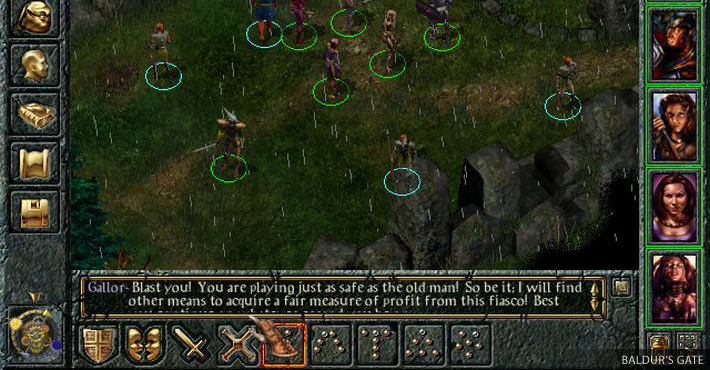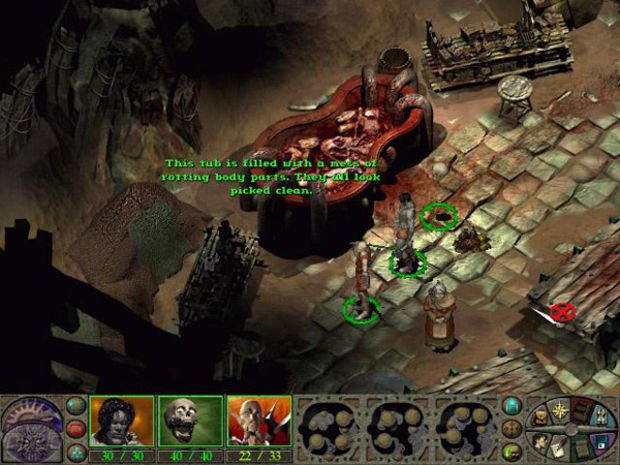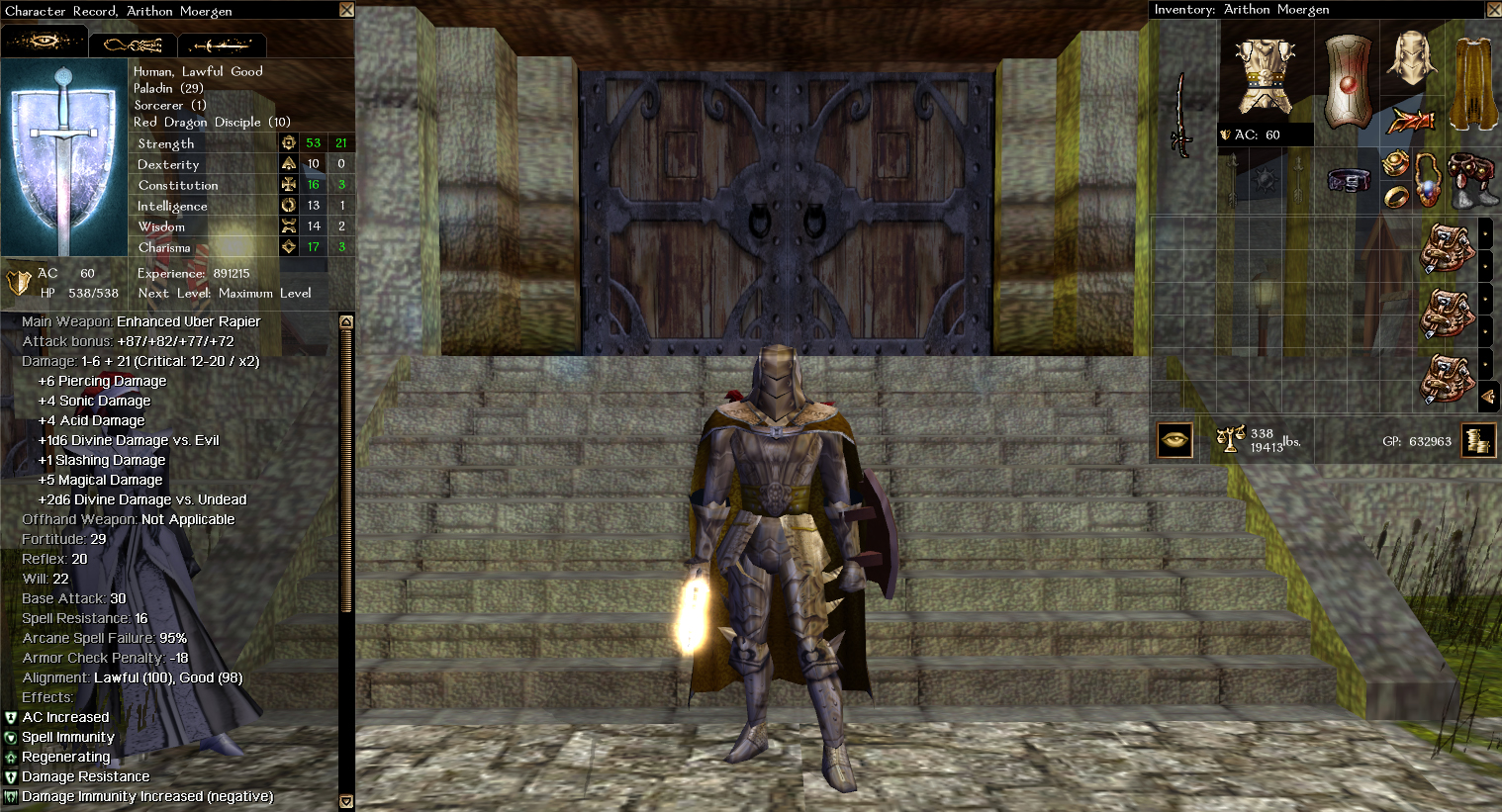The history of RPGs
Our comprehensive guide to PC RPGs spanning four decades—from Dungeon to The Witcher 3.

Baldur’s Gate beckoned players in with beautiful graphics, a heavy focus on story, and some of the genre’s most beloved characters. It looked fantastic, thanks to the Infinity Engine’s method of displaying worlds. Huge rendered maps with overlaid sprites allowed for exquisite detail without the predictability of tiles. It wasn’t just D&D reborn, but a new start for the genre. RPGs were finally cool again.
Replayed now, it’s the complexity that jumps out. Baldur’s Gate was based on AD&D Second Edition, and it doesn’t hide the fact. It wants you to know its dice rolls. It wants you to know terms like THAC0 (“To Hit Armour Class Zero,” aka, the likeliness of a hit landing). It often pushes you to areas you’re not ready for. Roll a mage and wander to the first real fight in the game—an ambush at the Friendly Arms Inn—and watch as a single hit lands like an anvil to the face.
It was still an RPG of its time, rooted, for all its attempts to welcome new players, in the designs of the past. It was BioWare’s first RPG, and the company hadn’t even formed with a plan to make them. The founders had intended to start a medical software company, before deciding games would be more fun. Previous releases were mech game Shattered Steel and comedy shooter MDK 2. Even Interplay, the publisher, had only moderate hopes for Baldur’s Gate. Two million copies later, BioWare was the new cool kid in town.
THE AGE OF INFINITY: 1998—2002

Experiencing Infinity
Unusually, while Baldur’s Gate struck a chord with players and became a huge hit, it was its engine, Infinity, that players came to love. When Obsidian ran its Kickstarter for Pillars of Eternity, it wasn’t the prospect of a game like Baldur’s Gate that excited people, but an updated Infinity Engine.
Exactly why Infinity became so famous is a bit of a mystery. There were only five games that used it—Baldur’s Gate, Baldur’s Gate 2: Shadows of Amn, Icewind Dale, Icewind Dale 2 and Planescape: Torment. The likely answer is that, because both BioWare and Interplay development group Black Isle Studios were using the engine for different projects (BioWare on Baldur’s Gate, Black Isle on the others), it was easier to identify the games by what unified them—the things that ensured everyone knew exactly what subset of RPGs was being discussed. Sprites over renders, pausable real-time combat, and so on.
Baldur’s Gate was the traditional RPG of the set, with the sequel going even further to try to give the experience of playing the pen-and-paper game in all its glory. Both games responded to your character, alignment determining who would stick to your party and who would walk off in a morally upright huff. Both also offered lots of exploring, whole areas dedicated to optional side-quests. Baldur’s Gate 2 cranked it higher still, with vast amounts of dialogue, inter-party chat, a second act that was like seven full AD&D modules glued together, optional romances, and more. The plot was better, and hugely helped by bringing in voice talent such as David Warner as the villain, Irenicus. The writing was funnier and sharper. Instead of a million NPCs willing to join the party, most of them forgettable, it trimmed the cast down to just the team’s favourites.
At the same time, Baldur’s Gate 2 didn’t sit on its laurels. It took some dramatic risks, including setting much of the action in a city where casting magic is against the law.
At the same time, Baldur’s Gate 2 didn’t sit on its laurels. It took some dramatic risks, including setting much of the action in a city where casting magic is against the law. This might not sound like much, but compare it to later games like, hypothetically, BioWare’s own Dragon Age 2. Few mainstream RPGs have the guts enforce a rule that makes one of the most popular classes that hard to play: casting a spell in public summoning a Cowled Wizard to demand an apology or justice. Baldur’s Gate 2 did, forcing mages to keep the magic to a minimum until they can either afford a licence, or become bad-ass enough to smack down the Cowled Wizards and convince them that you’re out of their league. It’s a shame too, because reaching that point of untouchability really is a wonderful feeling, versus simply being told not to use magic and having every guard you pass turn a blind eye to your firestorms in the name of game balance.
Keep up to date with the most important stories and the best deals, as picked by the PC Gamer team.
Away from Baldur’s Gate, Icewind Dale and its sequel offered a different spin on adventure. While they still had a story, quests and so on, their focus was tactical combat. You had a whole team from the very start, and had to use them wisely. Between you and the final boss was a gauntlet of fights. The focus was on managing your team’s firepower and tactics, rather than worrying about who liked who (or even who might be up for a tersely written sex scene.) They’re easily the most Marmite of the Infinity Engine games, but developed a huge following of their own.

The nature of a man
Finally, there was Planescape: Torment. No introduction should be necessary. Despite what is often claimed, it wasn’t a flop. It wasn’t a hit either, though, which, along with the desire of the current owners of AD&D to move away from the Planescape setting as a whole, was enough to guarantee we’d never see a sequel. At least, not an official one. Thanks to Kickstarter some of the original team is working on a spiritual follow-up called Torment: Tides of Numenera that’s due out in 2017.
Torment is the story of The Nameless One, an amnesiac immortal who has lived innumerable lives—some good, some bad, and one judged so terrible that even eternity is insufficient time to atone for his crimes. Along with a team of equally broken damned souls, including sarcastic skull Morte, a suit of armour animated by the spirit of justice, a chaste succubus who runs a brothel devoted to intellectual lust, and a man who is literally a doorway to a plane of fire, he has to find out the secret of his immortality before an unseen enemy finally destroys all the clues leading to the truth.
The main complaints about Planescape: Torment at the time look amusingly trivial in retrospect.
Torment is easily one of the best written games ever made, and a personal favourite. It’s dark, it’s funny, it’s philosophical, and every line is as smooth as a master barber’s razor. Not only is The Nameless One’s story far more fascinating than any plot with the word ‘amnesia’ in it has any right to be, but the world of Planescape is unlike anything games had ever tried. It’s a place where belief has power, with a central city, Sigil, full of doors to every conceivable world. If you’re lucky, you find the one you want. If you’re unlucky, you can simply cross a threshold and end up in Hell. Or worse.
One section in particular stands out as an absolute masterpiece of RPG design. The Nameless One begins the game as a fighter, but as he’s been the pinnacle of literally every class in existence at some point over his tortured life, it’s not hard to swap to another class if you can find a trainer to jog his memories. For mage, that’s the village witch, Mebbeth. Before Mebbeth will teach him anything, she has a few odd-jobs down at the village. One is to fetch a herb which nobody has seen before, forcing him to will the seed into growth. Another is to get some rags, starched so often as to be useless. A third trip, at this point ignoring his and the player’s irritation, requires him to go get some ink. All fairly standard fetch-quest stuff, with a little Planescape weirdness seemingly thrown in for flavour.

In this case, though, it’s not. As the quest ends, Mebbeth essentially sits back and asks “So, what have you learned so far?” And if The Nameless One is smart enough, he realises—that in those quests he’s been shown how belief works in the Planes and how to shape it to his will, the futility of ritual without reason, and finally that no matter how much a person knows, there is always something to learn. Magic has never been taught with such a practical focus; your first step not being to decide what kind of magic missile you want, but how to better see the universe.
The whole game is written with this level of love and detail. The Nameless One can be a force of great good to the Planes, or true evil. You can heal your friends’ broken souls, or sell them into slavery. You can use and abuse your immortality as you see fit, to get through a lethal tomb, or to manipulate a preacher into killing himself by offering to go first, respawning, and declaring “Your turn.” The journey goes from the filthy streets of Sigil down to the abyssal planes, where the only half-friendly life is a pillar of the skulls of wise men whose advice sent others to their doom. Throughout it all, it’s not a big villain that truly defines the story, but a simple question: “What can change the nature of a man?” It’s a question Torment poses, but you have to answer.
The main complaints about Planescape: Torment at the time look amusingly trivial in retrospect. The combat isn’t great, and there’s never any tension because you can almost always respawn, wade back into battle, and win through sheer force of attrition. There aren’t many companions compared to other Infinity Engine games—just seven, with two of those being secrets. It’s not a difficult game either, happily exchanging raw challenge for rewarding exploration and telling its story. If that sounds familiar, it should. It would become the model for most of the next generation of games, even after the Infinity Engine became just a fondly remembered bit of gaming history.

Echoes of infinity
While there were only five games based on Infinity, its legacy lasted a little longer. BioWare’s next engine, Aurora, was largely about bringing the experience into 3D. Its big debut was in Neverwinter Nights, which combined a pretty dreadful campaign with tools that players could use to create their own single- or multiplayer 3D adventures from scratch. These systems were fairly complex, but the audience soon rose to the challenge with everything from the comedic Sex And The Single Adventuress and the detective-focused Maugeter, to persistent online servers for full MMOs.
Already though, BioWare was tiring of the limitations of the top-down, old-school RPG, and looking for the next step. Aurora really only saw use in Neverwinter Nights, its sequel (made by Obsidian), and, out of seemingly nowhere, (though a heavily reworked version of the engine), the first of the Witcher games. Black Isle, meanwhile, didn’t survive the Infinity era. Its final published—though not developed—game was a mix of magic and the Crusades called Lionheart, which started reasonably well but quickly puttered out into a disappointing mess. After that, it was intended to go on to a new game, Torn, as well as sequels to both Fallout and Baldur’s Gate—Van Buren and The Black Hound respectively.
The Black Hound was going to be the start of a whole new series rather than a continuation of the previous games’ story, with the tagline “You cannot kill guilt”. It would have seen a new hero bound to its essence and growing stronger through dark actions, using a new engine called Jefferson. Why not Infinity? Because as popular as it is with fans, everyone who’s used it agrees that, under the hood, it’s a mess. Much like BioWare’s Aurora, Jefferson was going to be the same basic idea, but in 3D.
Financial problems at Interplay led to the entire team being unceremoniously booted to the kerb. Interplay would later try one of the more desperate crowdfunding campaigns, asking fans to contribute to the rebirth of Black Isle to create an online Fallout game—something allowed even after selling the main licence to Bethesda. Its only goal, however, was to fund a tech demo to try to attract investors, and none of the actual Black Isle staff from the company’s glory days were involved. As expected (and deserved), it failed miserably and with much mockery.

Beyond infinite
Despite its importance to RPG history, Infinity’s reign as both an engine and a style of game didn’t last very long. Fast forward to now, however, and it lives on. As noted, Obsidian’s Pillars of Eternity tries to replicate it using modern technology. Former BioWare member Trent Oster, however, is still using the creaky old thing directly, originally in the form of Enhanced Editions of Baldur’s Gate 1, 2 and Icewind Dale, and in the a brand new adventure Siege of Dragonspear, which takes place between the two Baldur’s Gate games. Dragonspear had a mixed response, for both good reasons and a few honestly very silly ones, but was a decent enough interquel on its own merits.
As for the rest of the industry, with the exception of a few indies, time has very much moved on. Since Baldur’s Gate, RPGs have gone from a struggling genre to the home of some of the best AAA releases in the world, and a genre that it’s cool to play... even if the transition to the mainstream has robbed it of much of what made it popular in the first place.
Our history of RPGs concludes overleaf by exploring the genre from 2003 onward.

